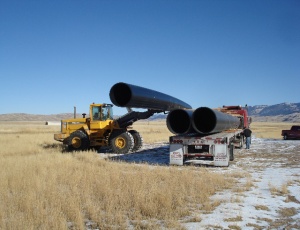A California contractor was awarded one of the largest U.S. Fish and Wildlife Service American Recovery and Reinvestment Act contracts for a $5 million irrigation project in the National Elk Refuge near Jackson, Wyoming.

Yerba Buena Engineering and Construction, Inc. a San Francisco-based minority-owned small business will install more than 5 mi of irrigation pipe in the 25,000-acre park to replace what Fish and Wildlife Service spokesman Michael Mascari called “pioneer-era canals.”
Yerba Buena proposed using polyethylene pipe and small sprinklers. The raw materials are more expensive than polyvinyl chloride (PVC) pipe, but because of their flexibility, less expensive to install and more durable than the rigid alternative.
The K-Line irrigation system can be moved around by Fish and Wildlife employees as needed and eliminates the need for diesel-fueled pumps.
“This is a routine project except for the size and timeline,” says Yerba Buena Project Manager Lee Barrus.
Work must take place in the four months when the elk leave during the summer to graze and must be complete by the time they return in August. Barrus plans to employ 50 people, many through local subcontractors, to work in shifts to meet the aggressive deadline.
Yerba Buena worked on a similar Fish and Wildlife project a year ago when it installed a new water diversion at the Coleman National Fish Hatchery in Northern California. The company also has a contract with San Francisco Public Utilities Commission to maintain the aging Hetch Hetchy Water conveyance system.
The new irrigation system, funded by $4.3 million in ARRA dollars, will be more efficient, more aesthetically pleasing and create additional habitat.
Mascari called the project “environmentally significant.”
Elk on the refuge rely on a winter supplemental feeding program that concentrates the herd and increases potential for disease transmission. Increased natural food production from this irrigation project will reduce reliance on supplemental feeding and allow the elk to disperse to a larger area, reducing the potential for disease and save up to $1 million a year in feeding and $5,000 in pumping costs.
More than 7,000 elk make their home in the refuge during winter and 46 other mammals, including bison, and nearly 75 species of birds move through the park throughout the year. More than one million human visitors come to the refuge annually.
The Elk Refuge project is one of $3 billion worth of ARRA projects funded through the Dept. of the Interior, $280 million of which will be funneled through the U.S. Fish and Wildlife Service.


Post a comment to this article
Report Abusive Comment